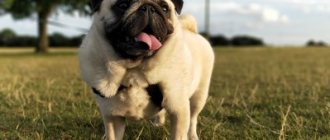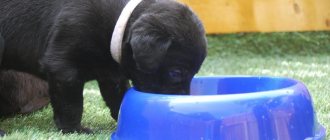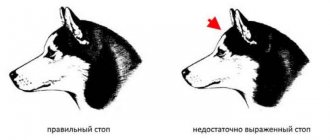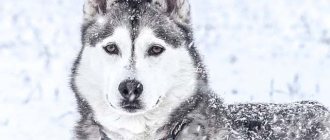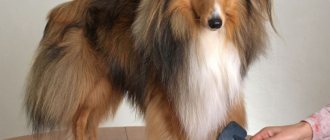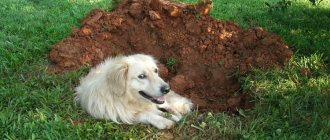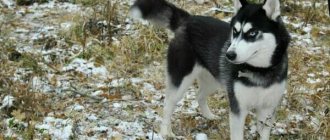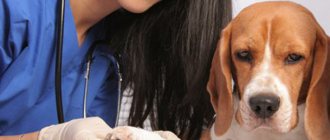Siberian Huskies have a beautiful thick coat and a dense, soft undercoat. Caring for representatives of this breed is quite simple and does not require a specific approach, experience or skills, but owners should know how to properly care for the coat of a Siberian Husky so that the dog looks well-groomed and the coat is beautiful, shiny and elastic.
According to the breed standard, the Siberian Husky's coat should be double, soft, pleasant to the touch, fluffy, and of medium length. The undercoat is soft and dense, but during shedding the undercoat may be completely absent. The guard hair is of medium length, smooth, not too soft and not too hard. Excessively long, coarse and harsh hair is not allowed.
The coat of Siberian Huskies perfectly protects animals from piercing cold, freezing wind, frost and other atmospheric phenomena, and also acts as a barrier to water. It is enough for a husky to simply shake itself off and the coat will become dry again, so when returning home after a walk from rainy weather, to dry the coat, wipe it with a dry towel. Unlike adult dogs, the coat of puppies is softer and before the appearance of guard hair, babies need to be thoroughly dried with a hairdryer and toweled after swimming or rain, so that the pet does not get a cold.
Proper coat care
Caring for the Siberian Husky's coat comes down to regular brushing, so immediately after the puppy arrives in your home, you need to purchase special brushes with medium-length metal teeth, a comb and a slicker brush. You need to accustom your pet to hygiene procedures from an early age. Husky is a very clean breed of dog; its fur has no characteristic odor and is capable of self-cleaning. To ensure that your beloved pet looks well-groomed, has an attractive appearance, and the coat is clean, beautiful, elastic and shiny, it is enough to comb the dog well once a week. Huskies shed twice a year, in spring and autumn, and during this period they brush the dogs daily, first using a slicker brush, which removes all dead undercoat, and then a fine-tooth comb or metal brush. You need to comb with smooth movements, without jerking or strong pressure, along and against the growth of the fur. Particular attention should be paid to the tail, “pants”, collar, hair between the ears and on the front legs. If your husky is kept in an apartment, it is best to brush your pet twice a day during shedding.
Until 5-6 months, you need to remember that the puppy’s coat is very soft, so before the formation of guard hair, in order not to accidentally injure the skin, comb the pets with a soft massage brush with rounded tips on the teeth.
Bathing Siberian Huskies
Siberian Huskies should not be bathed too often. Bathing pets using special shampoos for animals is carried out two to three times a year, as the coat becomes dirty. After each walk, you must wash your pet’s paws, and you need to teach this hygiene procedure immediately after the first walk, since not all huskies enjoy this procedure.
Read also
He is distinguished by his friendliness and exceptional devotion. A strong, hardy dog with a huge amount of agility.
Representatives of the breed are hardy, energetic, have a good-natured disposition and a cheerful temperament.
A proper, balanced diet is the key to good health and good physical condition. You need to know what should form the basis of a pet’s diet.
One-year-old husky dog, female. A lot of hair is falling out, the undercoat has been combed out, only long hair remains and continues to fall off.
Answer
Husky is a northern dog breed. Designed specifically for transporting heavy loads over long distances. The breed is extremely hardy. The dog requires constant exercise, and during “simple” conditions its state of health worsens. Work is in the dogs' blood. Huskies' closest relatives are wolves, so dogs can easily tolerate frost, are able to sleep in the snow at temperatures down to -50°C, and are endowed with good immunity. The fur is thick and odorless.
The unusual beauty of the breed has become the reason for the popularity of huskies among dog lovers in the middle zone and in the southern part of Russia. When you decide to get a husky, choose the time and carefully study the nuances of care. Pay special attention to caring for the animal's fur.
Hormonal reasons
They are determined by uniform molting and a number of indirect signs.
- Excess cortisol. The dog drinks a lot of water and gains weight. There is a relapse of infectious diseases and frequent urges to relieve oneself.
- Puberty period.
- Excess estrogen. Females lose hair around the genitals, and the foreskin of males swells.
- Lack of estrogen as a consequence of sterilization. Hair growth around the vulva and then throughout the body slows down.
- Lack of hormones produced by the thyroid gland. The coat becomes dry, brittle and falls out. Bald spots form across the body. The dog gets sick more often, becomes lethargic, and gains weight.
These alarm bells indicate the need to urgently contact a veterinarian. Self-medication with an unknown diagnosis will lead to a sharp deterioration in the animal’s health.
Non-hormonal reasons
The list includes external factors and diseases. Common reasons:
Treating a disease is much more difficult than preventing it. Regular visits to the veterinarian and adherence to the vaccination schedule help keep your pet healthy. If there is excessive hair loss, the doctor will do tests, make a diagnosis and prescribe treatment. Recommendations for care and nutrition are strictly followed. Then communication with your pet will be long and joyful.
Ever since a man tamed a dog, it became a truly close friend for him. And often even a family member. When choosing a dog, people are guided by different preferences. Some love large animals, some small, some shaggy or, conversely, bald.
But the increased popularity of smooth-haired dogs has good reasons. After all, an integral part of living with a dog is caring for and cleaning it. Especially during the molting period.
It is normal for a dog to shed twice a year. However, this is not an easy test for the hosts. What can be done to speed up this process? And what to do if the animal suddenly begins to shed heavily?
Breed Features
You can find a lot of conflicting information on the Internet or in specialized literature about how to properly care for a husky. Some “experts” insist on the need for daily hour-long acts of combing, forgetting that they are not dealing with a lapdog, but with a service dog, accustomed to very harsh and even harsh conditions.
Like any other furry breed, huskies have periods of shedding. Evolution has endowed these dogs with a luxurious double coat that can protect them from the piercing icy northern wind and snow. Shedding periods occur twice a year and can last from one to two months.
During this time, it is recommended to comb out excess hair that falls out in order to spend less effort on cleaning in the future. In addition, you can periodically remove loose hair using a special comb. The most optimal period for performing this procedure is once a week.
What is this
Animal hair is significantly different from the hair that grows on the human body. Of course, each dog breed has its own unique hair characteristics. But they all have one thing in common - the cyclical nature of hair growth and loss. A dog's fur does not grow continuously. After the so-called rest period, the dog begins to rapidly grow hair. After some time, this fur dies and is shed. Moreover, during molting, almost all the hair on the animal’s body is renewed.
After this, the hair begins a new cycle - it begins to grow again. This period lasts on average 130-140 days
.
The onset and duration of shedding depends on whether the dog is in its native climate. For example, a husky living in the north never sheds sharply, but changes its hair coat constantly throughout the year. A dog of the same breed living in the central zone sheds its hair like other dogs - twice a year.
Depending on the temperature outside the window, a more intensive renewal of one of them occurs.
Normally, dogs shed in spring and early fall and last one to two weeks. But there are a number of additions to this rule:
- Long-haired dogs (for example, breeds such as Afghan Hound, South Russian Shepherd) need brushing all year round, regardless of the season. Their outer layer of fur changes continuously.
- Bitches begin to shed unexpectedly during the period of estrus. Usually it is shorter lasting, but quite intense.
- Typically, females shed more than males.
- A dog may shed a lot if it suddenly moves to a hot climate.
- In dogs with thick undercoat, the shedding period can last up to 3-3.5 weeks. The fact is that first the dog sheds part of the outer layer, and only then the undercoat sheds.
There are also such dogs, it is important to purchase them from experienced and trusted breeders, because this property is traceable by pedigree. But you shouldn’t expect that you will never find hair in the house - after all, occasionally, the hair of such dogs falls out. These breeds include: Poodle, Chinese Crested, Miniature Schnauzer, Giant Schnauzer, Fox Terrier, Airedale Terrier, Yorkshire Terrier, White, Scotch, Boston and Staffordshire Terriers, Brussels Griffon, Bichon Frize, Basenji.
Molting: what you need to know
Many people who are new to this experience look forward to this event as a nightmare. Indeed, a lot has been said about molting that occurs in autumn and spring. The first shedding can occur in a puppy at approximately 3-10 months. Wool actively falls out within about three weeks, and in warm climates it can generally be renewed little by little throughout the year. But with proper care there will be no disaster.
It is necessary to devote time to brushing your pet every day. It is possible that you will need to do this even twice a day.
First, you should go over the fur coat with a slicker brush - it will remove the so-called dead undercoat. Then you need to arm yourself with a fine-toothed comb or a wire brush. But no matter what the combing is done with, the movements should be smooth. No jerking or pressing!
When does seasonality occur and its causes?
When does our wet noses begin to lose hair? A dog's coat is renewed twice
in year. This is a natural and natural process, laid down genetically. After all, hair helps a pet adapt to weather conditions and feel comfortable when temperatures change.
When does the spring season start? in spring
The dog loses its thick, long coat – the outer layer. The undercoat becomes much thinner and softer. Spring shedding in dogs usually begins after the end of frost.
in autumn
the light coat is replaced by a coarser one with a thick, dense undercoat - so that the dog does not freeze during cold weather.
Preventive and therapeutic measures
Treating a disease is much more difficult than preventing it. Regular visits to the veterinarian and adherence to the vaccination schedule help keep your pet healthy. If there is excessive hair loss, the doctor will do tests, make a diagnosis and prescribe treatment. Recommendations for care and nutrition are strictly followed. Then communication with your pet will be long and joyful.
Shedding in dogs, be it a huge mongrel or a tiny decorative Chihuahua, is an obligatory and normal occurrence. It is important that the molting process is only a signal that the time has come, and natural programs are activated in the dogs’ bodies, providing them with warmth in winter or protection from overheating in summer.
How long does it last
The average duration of molting is from 7 to 14 days.
It all depends, firstly, on the breed of the pet. The longer and thicker the coat, the longer it will take to change the coat. Secondly, animals that live in an apartment or house all year round cease to react sharply to temperature changes. Therefore, their molting can continue all year, only slightly intensifying in spring and autumn.
The described process refers to natural or planned molting.
. It is impossible to avoid it or influence its speed, so during such periods it is important to help your pet by brushing it daily.
The condition of a dog's coat is an indicator of its health.
Ideally, the coat should be smooth, silky and shiny. If you notice that every day your hair becomes duller, hair constantly falls out, bald spots appear or looks sloppy, immediately contact a specialist. The sooner you diagnose the cause of the illness, the sooner you can begin treatment.
Why does hair fall out in winter?
If any problems happen to the dog, the owner does not notice alarming symptoms until hair loss begins. What is hidden behind molting in winter and what to do?
Unfortunately, unscheduled winter shedding is a problem that most dog lovers face. If you notice that the animal is shedding, carefully analyze the previous month - were there any alarming symptoms? Maybe the dog was itching more than usual or was very lethargic and inactive.
Advice
: A good way to stop shedding is to let your dog bathe in clean snow.
Reasons for early shedding in winter (for example, in February):
IMPORTANT: If you find a lice eater, be sure to take an additional anthelmintic. After all, lice eaters can carry worms.
When does the first one start?
At what age does hair loss first occur? Age-related shedding is a natural process that all dogs undergo at a certain age. The first shedding occurs at approximately two months
(or less) – when the puppy fluff is replaced by the first coat. This coat is usually a different color from that of a puppy. It can be a couple of shades darker or lighter. Teenage fur already resembles the fur of an adult animal in structure and properties.
The next moult occurs at approximately six months
. From this point on, the dog's hair will gradually change, forming a denser and thicker layer. In some breeds of dogs (long-haired with a thick, dense coat), several molts must occur to completely get rid of teenage hair.
How to fight: express (artificial)
A so-called “express shedding” service for dogs is currently available. It is offered in almost every pet salon, although some owners carry out this procedure on their own at home.
Express shedding at home for dogs - how is it done? How to speed up shedding?
It consists of washing with a special product in very warm water. Then the mask is applied. The animal is covered with a film and a towel on top. This creates a sauna effect. Thanks to this, the pores open and all the hair ready for shedding is removed much faster.
The mask is washed off, and the coat is thoroughly combed, exposing the coat to hot air using a hairdryer. Express shedding removes almost 90% of shed hair.
IMPORTANT: This procedure is absolutely safe for the animal. But this service is not suitable for dogs that are not accustomed to bathing, brushing and blow-drying.
What to do if it is very strong?
The situation is completely different when unscheduled, prolonged or very intense molting begins. This may be a signal of either age-related changes or disruptions in the functioning of the animal’s body.
If you notice that your pet is shedding more or for longer than usual, the first step is to contact your veterinarian. It is better to immediately conduct an examination and, if necessary, get tested.
The most common causes of severe hair loss:
To help your pet during the period of intense molting, it is necessary. This is easy to do with the help of products sold in pet stores. Select a brush that suits your coat type and carry out this procedure at least once a day.
This will not only get rid of hair on the floor and furniture, but will also significantly speed up the shedding process. The coat will renew itself faster and become silkier, because with the brush you are working on the dog’s skin layer, increasing the blood supply to the hair follicles.
IMPORTANT: Short-haired dogs, in addition to combing, must be wiped with a special terry towel. It should be tough to help the dog get rid of excess hair that the brush could not remove.
Character of the Siberian Husky
Bred to be a sled dog, it is a wonderful all-round breed. They are pleasant, alert and friendly. They have amazing stamina and are always ready to work and want to do something, so they need at least an hour of exercise a day. They should also be around people or other dogs at all times. They need friendly relationships. Bored or lonely, this is a destructive pet, tearing up the sofa and pillows.
They can easily destroy your home and yard if they decide it's a good idea (and they probably will at some point). This breed also loves to dig! They like to run and sometimes they like to escape. They cannot be kept without a leash. You will need a fenced yard and you will need to make sure that the fence is secure because if there is any possible way out, it will find it.
They are excellent escape artists (and they don't have good road manners, so they can get run over!). They are also known for being able to escape through the front door. If you've seen a discouraged woman running around town in a robe, you now know that she's probably chasing her Husky. They don't bark much, nor are they particularly protective, so they won't alert you when someone is at the door.
They are not very suspicious of strangers, and they are so indiscriminately friendly that if a burglar breaks into your home, your pet may try to lick him to death. They are friendly with children and love to play with them. They get along well with other dogs and love to play with other Huskies. They, however, are not at all friendly with cats. Unfortunately, they can kill a cat even with whom they lived for a while.
They need to be controlled around any small animals. They are smart and can be a little stubborn. They are bred to pull, so teaching them to stand still can be a difficult task. They also usually refuse to return when you call them. You will have to earn his respect and establish yourself as a leader. They have a playful behavior, attractive facial expressions and a strong love for life. They are friendly, loving and enjoy attention. And they need a lot of it.
How to speed up and reduce?
It is impossible to completely stop the process of hair loss. But you can speed it up. This will help your pet recover as quickly as possible.
- An essential condition is daily combing of the coat.
- To speed up hair renewal, washing your dog in warm water
using protein shampoo or a special product for animals during the molting period will help. After washing your pet, you need to wrap it in a towel for 1-2 hours. It is important to carefully monitor its condition to prevent overheating. Then the animal must be thoroughly combed. This will speed up the molting process, but you should not resort to this method too often. - If you want to improve the condition of the coat, it is important
your pet properly During this period, the dog spends a lot of energy on the formation of new hair. A complex of vitamins and a balanced diet will help the animal maintain health. - You can add vegetable oils or fish oil
at the rate of 1 teaspoon per 4.5 kg of body weight. Once a week you can give fillets of sea fish.
Siberian Husky coat care
It is better to accustom your pet to grooming from puppyhood, since the procedure of combing the fur should be carried out on a regular basis.
For combing, use a wide-toothed comb or a comb with curved teeth so as not to damage the skin. During the molting period, it is advisable to use a slicker, furminator or comb.
You should start from the head and work towards the tail, carefully untangling tangled hair. Then, using a soft brush, walk through the fur, first against its growth, then in the direction of growth.
A solution of wool conditioner and water, used to complete the combing procedure, helps cleanse the coat of dirt and adds freshness and shine.
In winter, the Siberian Husky also needs brushing. When wet, wool tends to form tangles, which reduce the thermal insulation properties of the undercoat.
It is not recommended to shave a husky's fur, because the coat not only regulates the dog's body temperature, but also protects the skin from the harmful effects of the sun. Shaving your hair increases your risk of developing skin diseases, including cancer. In addition, the undercoat and guard hairs grow back unevenly after shaving, which can be noticeable in some areas of the body.
She gained her popularity primarily for her unusual wolfish appearance and friendly disposition. Many people would probably like to buy such a puppy. However, according to experts, due to some character traits, this breed is not suitable for all dog breeders. In any case, caring for a husky must be done correctly.
Remedies and tablets from: what vitamins to give during?
Pharmaceutical companies offer a wide selection of vitamin and mineral complexes that help your pet quickly restore health and get rid of unplanned shedding.
It is important to understand what vitamins are necessary for skin and coat:
- Vitamin A
is the main anti-shedding vitamin and is essential in the synthesis of collagen, elastane and keratin fibers. If there is not enough of it, the coat becomes dull and brittle. Vitamin A (or retinol) is an essential component of any complex for dog hair. - Vitamin E
- helps cope with the negative effects of the environment. It is also called "tocopherol". Tocopherol significantly reduces the amount of hair falling out. - Vitamin C
– helps improve blood circulation and nutrition of hair follicles. With a lack of this vitamin, the animal's hair becomes dry and brittle. - B vitamins
are indispensable in the treatment of skin diseases and malfunction of the sebaceous glands. It is important to use these vitamins not only during illness, but also for prevention. - Vitamin PP
or nicotinic acid has a beneficial effect on the level of pigmentation. The pet's coat will be bright and shiny. - Fatty acids have already been mentioned above. Omega-3 and 6
help quickly renew hair. The wool becomes soft, elastic and shiny. With regular use of Omega, coat density approaches the optimal values for the breed. - Zinc
supports proper functioning of the thyroid gland. - Sulfur
not only helps to cope with seborrhea and hyperkeratosis, but also improves the functioning of the sebaceous glands. - The combination of phosphorus and calcium
is necessary to maintain the natural shine of the coat. - Manganese
is necessary for the synthesis of keratin. - Copper
allows collagen to form, which makes the coat soft and free from breakage.
Vitamin complexes and tablets offered by pharmaceutical companies include the Yumega Boost, Virbac Megaderm, and VitsCan
and
Safari Skin and Coat
.
IMPORTANT: Before giving your pet medications or any vitamin complexes, consult your veterinarian.
Prevention
How to protect your beloved pet from unscheduled shedding? This question is often asked by dog owners. After all, you want your four-legged friend to always be cheerful and healthy. For this, constant care and attention is important.
- Routine visit to the veterinarian.
Often, only an experienced specialist can replace the disease in the early stages, which will allow your pet to be quickly cured.
- Systematic inspection of the animal's home.
- Taking vitamins and proper nutrition.
Make sure that your pet eats regularly and only fresh food intended for its age and breed.
- Regular washing and combing of wool.
Still, you should not bathe your dog too often, but it is also undesirable to neglect hygiene.
- Peace.
Any stress causes irreparable damage to the animal’s psyche. Try to avoid this.
- Walks in the open air.
Walk your dog every day, even in bad weather. But be careful - do not allow the animal to overheat or hypothermia.
So, it is very important to monitor the condition of your pet and help him not only during periods of stress, but also to provide proper prevention. A dog is not only a source of joy, but also a great responsibility.
Preventing hair problems
The main factors affecting the general health and, as a result, the skin and fur of your four-legged friend are:
- balanced diet;
- maintaining hygiene;
- timely vaccinations;
- disinfection from internal and external parasites;
- physical activity;
- harmless contact with other animals.
Standard hygiene procedures, vitamin and mineral food supplements, visits to the veterinarian, regular walks regardless of the time of year in places where there are no stray animals will ensure that the pet’s autumn and spring shedding will not bring unnecessary trouble.
For loving and responsible owners, a pet's hair will always be its decoration and evidence that it is cared for as much as necessary.
The Siberian Husky has a double coat: a soft undercoat is protected by a hard outer coat. The outer coat has water-repellent properties, and the undercoat retains heat. The coat is designed in such a way that the animal can withstand the cold without harm to its health, living outside all year round.
Despite the thick coat, the Siberian Husky is distinguished by its absence of odor, because the coat has self-cleaning properties. Therefore, representatives of the breed do not need frequent bathing, which causes an unpleasant odor. It is enough to bathe your pet 1-2 times a year, otherwise skin problems may arise. After all, natural oils are washed off, which contribute to the self-cleaning of dirt from the cover.
Conclusion
- Shedding in dogs is divided into natural and unplanned.
- Natural molting occurs in the off-season, that is, in spring and early autumn.
- Unscheduled shedding can occur for natural reasons (estrus, stress, sudden climate change), or it can be an indicator of serious diseases.
- The dog begins to shed at the age of six months.
- It is important to brush your dog regularly to prevent matting.
- You can help your pet during this difficult period with the help of an express shedding service, proper diet and vitamin intake.
Surely each of you has your own secrets. What do you do during shedding? How do you deal with the amount of wool in the house? How is your dog feeling? Share information and, of course, a photo of your wonderful pet!
The Siberian Husky has a double coat: a soft undercoat is protected by a hard outer coat. The outer coat has water-repellent properties, and the undercoat retains heat. The coat is designed in such a way that the animal can withstand the cold without harm to its health, living outside all year round.
Despite the thick coat, the Siberian Husky is distinguished by its absence of odor, because the coat has self-cleaning properties. Therefore, representatives of the breed do not need frequent bathing, which causes an unpleasant odor. It is enough to bathe your pet 1-2 times a year, otherwise skin problems may arise. After all, natural oils are washed off, which contribute to the self-cleaning of dirt from the cover.
Seasonal husky coat care?
When caring for a dog, the owner must first of all brush and bathe it regularly (with shampoo no more than once a month, with the exception of the exhibition period). The animal's coat is shortened and less dense in summer. Wool in 2 layers provides the dog with a comfortable temperature regime: not cold in winter, not hot in summer. There is no need to trim it for the summer.
When the animal does not shed, the frequency of combing 1-2 times a week is acceptable. If a dog sheds (in spring and autumn) living in an apartment, the brushing procedure should be done 2 times a day. It is more appropriate to use a combing brush, which removes the remnants of dead undercoat. And at the second stage, move on to a fine comb, taking into account the pet’s thick undercoat. This ensures the husky's presentable appearance and the absence of dog hair on the carpets.
What cosmetic products are used to care for Huskies?
When bathing, use shampoos (medicated, for different skin types, for volume, whitening) and conditioner. Different shampoos are used for the torso and for the white areas of the coat. Conditioner applied to wool after detergent must be thoroughly rinsed. After the water procedure, the pet is wiped with a towel and dried with a hairdryer. When the coat is dry, it is combed with a massage brush and then with a comb. Ears and eyes are cleaned with cotton swabs.
Taking into account the fact that puppies need to be accustomed to the process of brushing, they should be brushed more often than adult dogs. The wool is softer and until guard hairs appear, take care to prevent colds. To do this, bathing ends with drying the wool with a hairdryer and wiping with a towel.
It is recommended to accustom your puppy to hygiene measures from the first month. The combing process is carried out with smooth movements along and against the wool. Brushing should be concentrated on the tail, outer thighs, collar and back of the head. Until guard hairs form at 20-24 weeks, the puppy’s soft coat is combed with a massage brush with rounded ends on the teeth.
Adult Husky coat care
Dog hygiene procedures boil down to washing the face, checking the claws, and combing the fur. It is recommended to give treats after these procedures for excellent behavior.
Caring for a husky's coat is not difficult, and if the owner of a husky does it correctly, his pet will look well-groomed and beautiful.
It is important to know that cosmetics for exhibitions and everyday care should be different.
The Siberian Husky has a double coat: a soft undercoat is protected by a hard outer coat. The outer coat has water-repellent properties, and the undercoat retains heat. The coat is designed in such a way that the animal can withstand the cold without harm to its health, living outside all year round.
Despite the thick coat, the Siberian Husky is distinguished by its absence of odor, because the coat has self-cleaning properties. Therefore, representatives of the breed do not need frequent bathing, which causes an unpleasant odor. It is enough to bathe your pet 1-2 times a year, otherwise skin problems may arise. After all, natural oils are washed off, which contribute to the self-cleaning of dirt from the cover.
Shedding a Siberian Husky
The first shedding occurs in puppies at the age of 10-14 months. During this period, hair change occurs. In adult dogs, the shedding process lasts up to 6 weeks.
The shedding period for husky owners can seem like a nightmare, because the hair falls out profusely, is easily pulled out in clumps, and remains wherever the dog has passed. Therefore, in addition to combing, you will need to regularly clean the house, armed with a vacuum cleaner and a brush.
Regular brushing will speed up the shedding process of your Siberian Husky. In addition to removing dead hair, combing, thanks to its light massage effect, promotes faster growth of new hair.
Hair loss is stimulated by heat. Therefore, during the period of heavy shedding, you can bathe the husky in warm water, then wrap it in a warm towel and try not to allow the animal to get rid of the towel for at least an hour. When exposed to heat, hair falls out more intensely. All that remains is to comb out the fallen hair.
In addition to brushing during the shedding period, the Siberian Husky's coat needs to be groomed at least once a week. Regular grooming will help maintain the shine and healthy appearance of the coat.
Why do Siberian Huskies shed so much?
Contents hide
“Who doesn’t love Siberian Huskies? Everyone loves Siberian Huskies!” This is the headline in one of the British publications that once caught the eye of the author of these lines. And it’s hard to argue: these lively, energetic and endlessly cute dogs have the magical gift of inspiring sympathy at first sight. Huskies are also loved by city residents - every year you notice more and more “Siberians” in courtyards, parks and dog parks. This is one side of the coin. And the other is that there are more and more announcements about the transfer of adult huskies “to good hands”; more and more of these animals end up in shelters and temporary detention centers. Why do you think?
We at ilike.pet have repeatedly raised this problem - we provide a link to one of the latest publications. The author received a lot of feedback, mainly from readers who were seriously thinking about buying a puppy of this breed. There is only one question - is everything really that bad? No, not bad at all! And huskies are really incredibly good! They just don’t feel comfortable living in a big and noisy city. Their element is nature, countryside spaces, meadows, fields. Dogs are characterized by a high level of activity, require attention, they need to be occupied with work and entertainment. Where are the residents of megacities who are always in a hurry and busy with everything in the world at the same time! But this is still not the biggest problem. Finally, you can rearrange your schedule, force yourself to devote more time to your pet, etc. The main problem associated with keeping a Husky is the coat. A lot of wool, a lot. It will fill your entire apartment. All your office and weekend suits will be covered in fur. And even the most powerful and modern vacuum cleaners will not help.
Features of the coat of Siberian Huskies. Dogs are adapted to life in the harshest climates and extreme temperatures. Nature itself took care of the survival of these dogs, providing them with a magnificent, incredibly dense and thick coat. It is truly “impenetrable” - it consists of two layers. Particularly noteworthy is the soft, fluffy and very dense undercoat, which, in turn, is covered with a layer of long, slightly straighter, harsh and coarse fur.
You will be surprised, but husky fur is unique! It allows the dog to maintain normal body temperature both in extreme cold and in the summer heat. Yes, when the thermometer is over thirty, the dog is hot and not entirely comfortable. Many compassionate owners, deciding to help their pets, begin to cut them almost bald in the summer. And they primarily do a disservice - since it is the dense and thick coat that helps dogs maintain normal thermoregulation.
How the Siberian Husky's fur grows. Unlike dogs of many other breeds, it is not cyclical, but stable and even throughout the year! Due to this circumstance, the density of the coat always remains the same, plus or minus (in summer, however, the coat is slightly less dense than in the winter months). But you won’t be able to tell from the outside – for you, the husky will remain furry even at the very zenith of summer!
How do Huskies shed? It is logical to assume: if fur grows all year round, it is also renewed all year round! This is why huskies shed consistently and a lot. Just call your pet and pet it! And you will probably have scraps of faded wool in your hands. The peak of shedding occurs, however, at the change of seasons - before the onset of winter and summer. Especially in the summer - then your apartment will literally drown in wool in just two weeks. Exactly when seasonal molting will reach its climax is difficult to predict. It all depends on the outside temperature. Are the first truly warm days here? Get ready! It's May, but it's still March-like cold? A wise husky will definitely wait for “real” warmth!
What to do? We again appeal to citizens interested in huskies. Have you changed your mind yet? Great! You understand that you will have to care for your pet on a regular (daily) basis. Be sure to thoroughly comb your dog during periods of active shedding - even twice a day! Don't let your dog go - she's uncomfortable with so much shed hair.
You only need a special tool that allows you to get to the undercoat. Do not limit yourself to “half measures”; do not brush along the sides and the outer layer of the coat. Complete cleaning only!
Remember - many townspeople also complain about the strong, characteristic smell of a dog emanating from huskies. How to fight? Daily care and bathing. Bathe your husky approximately once every six weeks (set the exact frequency yourself). Bathing will help at least partially solve the problem of odor and tufts of fur everywhere. But there are pitfalls here too. The “increased hairiness” of a husky can interfere with bathing in a regular bath. Probably, some owners are doing the right thing, who regularly use the appropriate services of grooming salons.
Photo: pixabay.com

